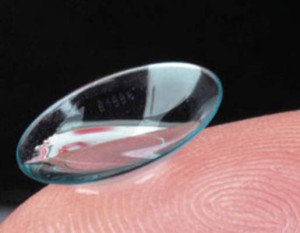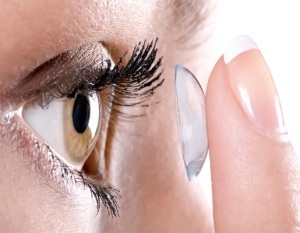Hard lenses
 Hard lenses, also referred to as RGP lenses, are relatively small lenses. As the name implies, these lenses are made of a hard material. In the Netherlands, these lenses contribute to about 40% of to all the contact lens wearers, where as in America it constitutes to only 10%. Previously, hard lenses were made of PMMA and this material did not allow oxygen to permeate and as you can imagine it was not good for the eye lenses. However, nowadays hard lenses are made of a material that does allow for oxygen to pass which is better for the eyes.
Hard lenses, also referred to as RGP lenses, are relatively small lenses. As the name implies, these lenses are made of a hard material. In the Netherlands, these lenses contribute to about 40% of to all the contact lens wearers, where as in America it constitutes to only 10%. Previously, hard lenses were made of PMMA and this material did not allow oxygen to permeate and as you can imagine it was not good for the eye lenses. However, nowadays hard lenses are made of a material that does allow for oxygen to pass which is better for the eyes.
Benefits
- Hard lenses are more expensive than soft lenses, but on the other-hand, they last almost 3 years. Since the hard lenses last longer than soft lenses, they are certainly cheaper in the long run. Soft lenses are cheaper and more affordable to buy but if you consider the fact that they are good for a maximum of only a day, a week or a month. After which you will have to buy new lenses. In the long term the cost of hard lenses is lower.
- Because the lens allows for more oxygen transmission there are smaller risks of infections. If you look at the statistics people that wear hard lenses are four times less likely to catch infections than someone who wears soft contact lenses.
Disadvantages
- For hard lenses, there is space between the lens and the cornea. As a result, there may be a possibility of a speck of dust that might come behind the lens. This sometimes makes hard lenses generally less comfortable.
- The lenses also require a fairly long time to get used. In the beginning, it will not be very pleasant to wear the lenses, but after some time the discomfort will eventually finish.
- You have a greater chance of losing your lenses if you wear hard lenses than when wearing soft lenses. Well of course this does not mean that they fall out with each and every movement you make; but certainly the lenses are not suitable for all sports and it is particularly advised to not go swimming with them on.
Soft lenses
 Soft lenses are larger than hard lenses, and cover a larger part of the eye. These lenses are made of a softer material that appears like perspex. In the Netherlands 60% of contact lens wearers wear soft lenses as compared to 90% in America. During the beginning and early days of its introduction, it was not possible to wear soft contact lenses if your eye sight had a special strength such as a cylinder. However, nowadays it is possible to wear soft lenses for any strength.
Soft lenses are larger than hard lenses, and cover a larger part of the eye. These lenses are made of a softer material that appears like perspex. In the Netherlands 60% of contact lens wearers wear soft lenses as compared to 90% in America. During the beginning and early days of its introduction, it was not possible to wear soft contact lenses if your eye sight had a special strength such as a cylinder. However, nowadays it is possible to wear soft lenses for any strength.
Benefits
- Soft lenses are very comfortable to wear. Because the lenses cover a large part of your eyes it is highly unlikely that there could be something underneath the lenses that could cause discomfort.
- The lenses remain well in place and are very suitable for sports. It is also possible to swim while wearing them; but you should still make sure that they fit well so that you do not lose them.
People can very quickly get accustomed to wearing soft lenses. This is the reason that people Buy Cheap Colored Contacts made of soft lenses.
Disadvantages
- The lenses are less easy to keep clean and therefore they need to be replaced more often than hard lenses. This makes soft contact lenses more expensive than hard lenses on the long-term of things.
- The risk of infection is automatically increased when wearing soft contact lenses. Also, you have more chance of getting neovascularization. This is because there is too little oxygen that actually reaches to your eyes.
